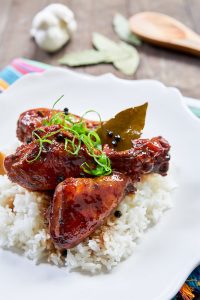【講師コラム】マデル講師 No.8

オンライン英語スクール Englishbuds 管理人 Mommy Kayo です。
最近ちょっと行事が立て込んでいて疲れ気味なので
週末がいつもよりも待ち遠しい私。。。
やったー!今日は金曜日です♪
今日の講師コラム担当はマデル講師です(^^)
フィリピン料理を紹介してくれることの多いマデル。
今日はフィリピンの伝統料理について語ってくれています。
どうぞお読みください!
Aside from beautiful its beaches, the Philippines is also known for its unique, flavourful and truly delectable Filipino dishes. Today, I would like to share about a super popular dish that almost all Filipino grew up with and has always been a favorite in every family’s kitchen: CHICKEN ADOBO! Many call it as the Philippines National Dish (although we don’t really have a national dish).
According to the history, when Spanish colonizers first took over the Philippines in late 1500s and early 1600s, they encountered an indigenous cooking process which involved stewing with vinegar. The Philippines is a tropical country. Since the weather is mostly hot, and at that time there were no refrigeration techniques, let alone electricity, foods would easily get spoiled. So our ancestors had this idea to use vinegar to keep meat longer and more flavourful when it was time for cooking. When spanish people arrived in the Philippines, they discovered that this cooking process is somewhat similar to their “adobar“. The Spaniards called this as an “adobo,” the Spanish word for seasoning or marinade. And as they say, the rest is history.
Traditional adobo recipes call for meat to be marinated and stewed in a flavorful mixture of vinegar, soy sauce and spices (garlic, bay leaf and black pepper). However, as years passed by, different provinces came up with their own renditions of adobo. Chicken and pork adobo are the most common renditions of the dish, but it’s not limited to meats. There’s also fish adobo, squid adobo, water spinach adobo and more . In terms of ingredients, it can also be diverse. For instance, we have adobo sa gata (adobo in coconut milk), adobong puti (adobo that uses salt instead of soy sauce), adobong dilaw (yellow adobo, because of turmeric), adobo with evaporated milk, adobo with pineapple chunks and many more!
Adobo is cheap, easy to cook and does not spoil easily. It has this irresistible aroma that that would instantly make you feel hungry once you smell it. Plus it really tastes heavenly!
Here’s a quick guide on how you can cook CHICKEN ADOBO.
INGREDIENTS:
4 to 5 whole chicken leg quarters, divided into thighs and drumsticks
6 to 8 cloves garlic, peeled and smashed
1/2 cup soy sauce
1/2 cup vinegar (rice vinegar and white vinegar)
1/2 cup water
1 tablespoon packed brown sugar
1 teaspoon black peppercorn, half left whole, half cracked slightly
2 bay leaves
COOKING INSTRUCTIONS:
In a bowl, MARINATE chicken in a mixture of garlic, soy sauce, vinegar, brown sugar and peppercorn. Set aside for 30 minutes.
Remove chicken and set aside marinade. Heat oil in a pan and brown chicken.
Add in smashed garlic and sauté until slightly browned. Pour in reserved marinade, bay leaves and water. Bring to a boil and cook until the chicken is tender and cooked through. Season with salt and pepper as needed.
Serve with hot rice and enjoy with you loved ones.Thank you so very much again for all your support to Englishbuds, Mommies and Daddies… Thank you for taking time to read this entry. And I do hope that you’ll be able to try cooking adobo one day. You’ll surely love it. Have a wonderful and relaxing weekend ahead!
日本にも酢醤油煮がありますが、それに近い味です。
フィリピン料理はフランス料理のように洗練されていたり
中国、タイ料理のようにそれほど個性的でもないため
知名度はイマイチですが、
ご飯が進む味付けで日本人には合うのではないかと思います(^^)
海外に出かけると
空港に着いたらすぐにうどん屋に直行したくなる私ですが
フィリピンから帰ってきたときは
日本食をそんなに恋しく思いませんでしたね。
私個人的にはフィリピン料理好きです(^^)
本場の味を楽しみに行きたいところですが
コロナが終息しないと無理ですね。。。(T_T)
それまでは
マデル直伝のレシピで楽しむことといたしましょう♪
皆様もよろしければ是非(^^)
レッスン料金など受講に関する詳しいご案内はこちらから♪
オンラインレッスンの会員登録はこちらから♪
MommyKayo提供サポートメニューはこちらから♪
各種お問い合わせはこちらから♪
応援お願いします♪



